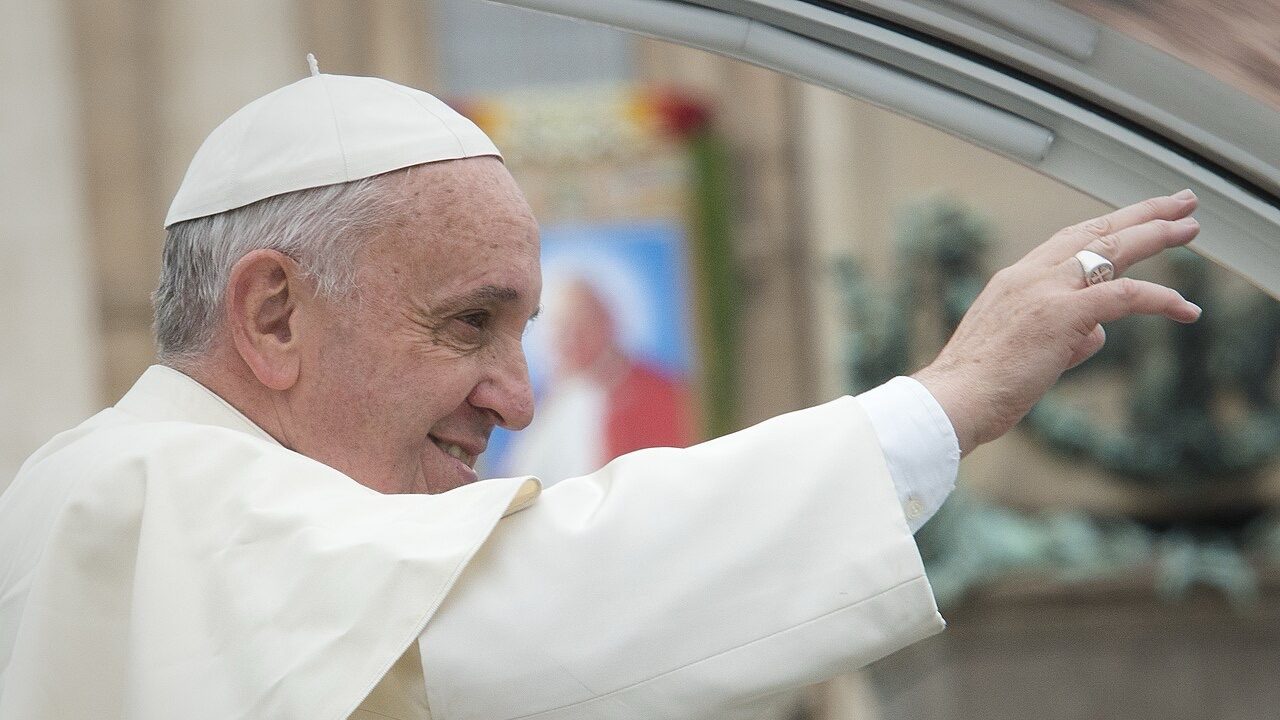Vatican City (WNEWS) – Pope Francis, born Jorge Mario Bergoglio, passed away peacefully on Easter Monday, April 21, 2025, at the age of 88, in his Vatican residence at Casa Santa Marta. His death ends a papacy that reshaped global Catholicism through humility, progressive engagement, and fierce advocacy for the poor, migrants, and the planet.
Francis had battled a number of health issues over the years and died early on Monday, April 21, just one month after he was discharged from the hospital, where he was treated for double pneumonia, following a 38-day stay.
The Vatican announced his death in a statement: “Pope Francis died on Easter Monday, April 21, 2025, at the age of 88 at his residence in the Vatican’s Casa Santa Marta.”
In a statement released by the Vatican, Cardinal Kevin Farrell said Francis died at 7:35 a.m. local time, early on Easter Monday.
“His entire life was dedicated to the service of the Lord and His Church,” Farrell said.
“He taught us to live the values of the Gospel with fidelity, courage and universal love, especially in favour of the poorest and most marginalised,” Farrell continued.
With immense gratitude for his example as a true disciple of the Lord Jesus, we commend the soul of Pope Francis to the infinite merciful love of the One and Triune God.”
His final days, marked by declining health and brief but meaningful public appearances, concluded just hours after an Easter meeting with U.S. Vice President JD Vance — a visit now seen as symbolic of the late pontiff’s enduring commitment to dialogue, even across political and ideological divides.
Declining Health and Hospitalization
On February 14, the Vatican confirmed that Pope Francis had been hospitalized at the Agostino Gemelli Polyclinic Hospital in Rome. Initially treated for bronchitis, Francis’ condition worsened over the next two weeks, developing double pneumonia. However, there were several days when the Vatican reported slight improvements in his condition.
An audio recording of the pope thanking people for their prayers was released on March 6. Although the Vatican did not offer many details, they said it was recorded from the hospital.
“I thank you with all my heart for the prayers you offer for my health from [St. Peter’s] Square. I accompany you from here,” he said in a message recorded in Spanish, Francis’ native tongue. “May God bless you, and may the Virgin protect you. Thank you.”
A Humble Ending to a Transformative Papacy
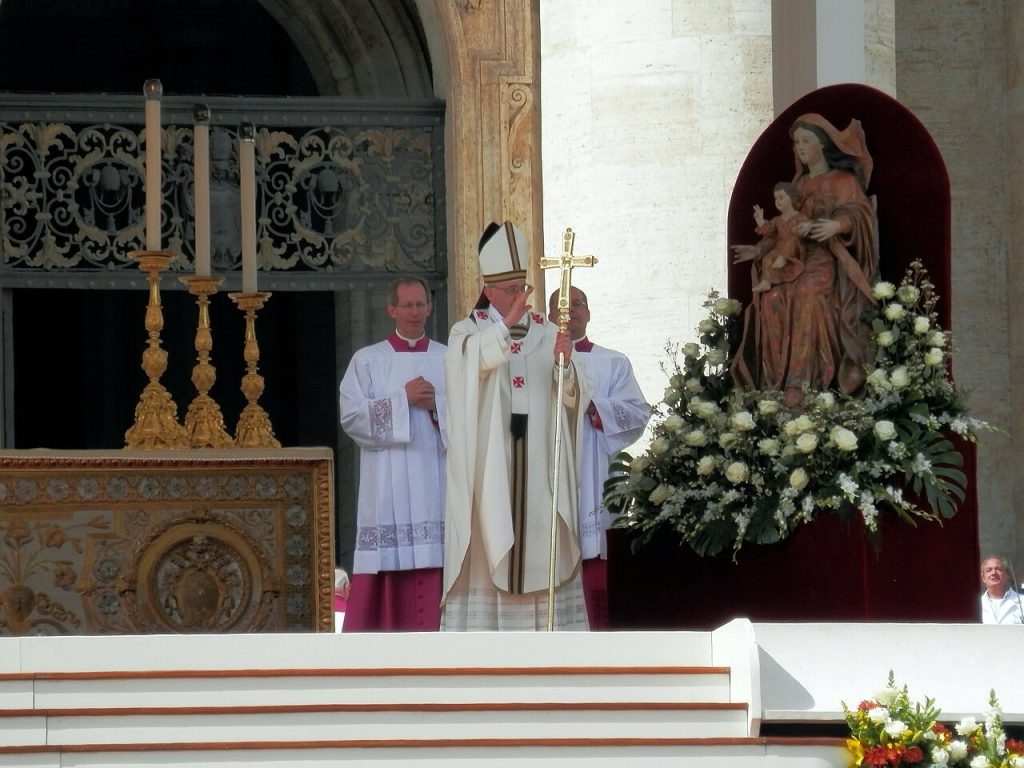
Pope Francis was the first non-European pontiff in over 1,200 years, the first Jesuit pope, and the first from the Americas. Elected on March 13, 2013, following the resignation of Pope Benedict XVI, he quickly gained international recognition for his modesty and pastoral focus.
He rejected the traditional papal apartments in favour of a simple suite in the Casa Santa Marta guesthouse. His early actions — such as washing the feet of inmates, including women and Muslims, during Holy Thursday services — set the tone for a decade-long effort to align the Church more closely with the marginalized.
Over 12 years, Francis took on entrenched Vatican bureaucracy, responded to child sex abuse scandals with mixed reviews, and emphasized climate change as a moral crisis. His 2015 encyclical Laudato Si’ placed ecological concerns at the heart of Catholic social teaching.
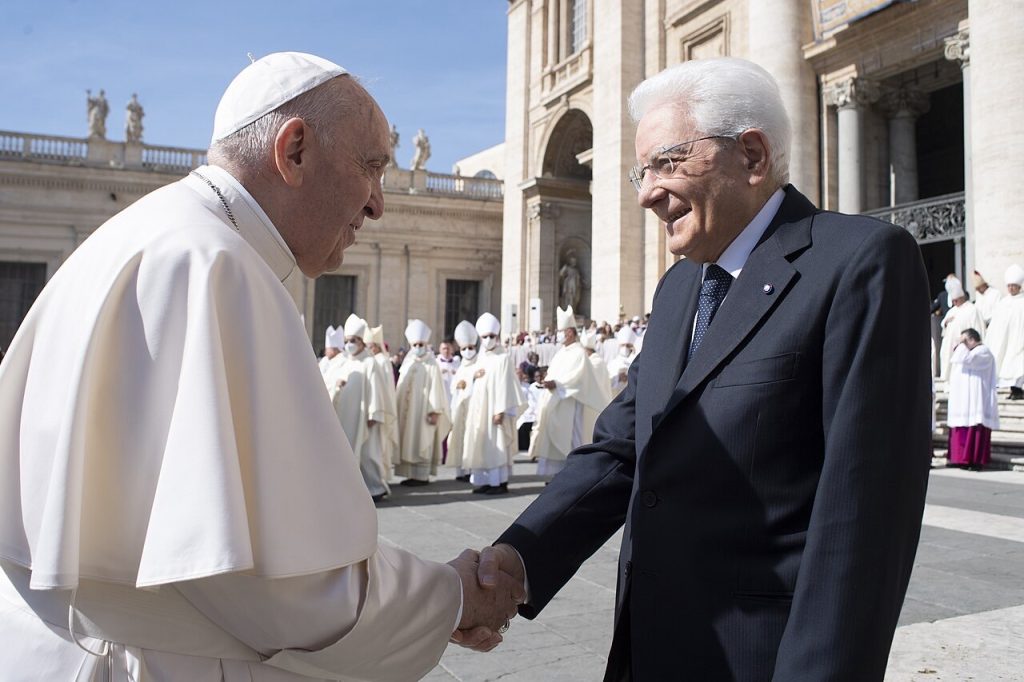
But his reign was not without controversy. Traditionalists accused him of sowing doctrinal confusion, particularly regarding communion for divorced Catholics and his outreach to the LGBTQ+ community. Nevertheless, Pope Francis remained steadfast in his belief that the Church must become a “field hospital” — a place of healing rather than judgment.
A Final Easter and a Quiet Goodbye
Despite ongoing health issues including colon surgery in 2021, bronchitis in 2023, and recent bouts of pneumonia, the Pope insisted on leading Easter Sunday prayers in St. Peter’s Basilica. Though visibly weak, he delivered a short Urbi et Orbi blessing from a seated position, urging for peace in Gaza, Ukraine, and “lands too often forgotten by men and God.”
Later that same afternoon, Pope Francis received U.S. Vice President JD Vance for what would be his final diplomatic meeting. The visit, originally scheduled as a formality, became one of lasting symbolic importance.
Vatican doctor Andrea Arcangeli released a death certificate on Monday for the 88-year-old Pope Francis. The certificate states that Pope Francis died of a stroke and irreversible heart failure.
The certificate, which was published by the Vatican, said the pope had fallen into a coma before his death early on Monday.
Meeting JD Vance: A Papal Farewell to American Power
The Pope met with Vice President Vance in his private quarters, where a Vatican interpreter facilitated the brief conversation. Vance, who is known for his populist conservatism and former authorship of Hillbilly Elegy, brought Easter greetings from President Trump and the American people.
Pope Francis presented Vance with a Vatican rosary and chocolate Easter eggs for his children. According to Vatican officials, he also offered a personal blessing — a gesture Vance later called “deeply moving.”
Vance posted on X, following the news of the passing of the Pope:
I just learned of the passing of Pope Francis. My heart goes out to the millions of Christians all over the world who loved him. I was happy to see him yesterday, though he was obviously very ill. But I’ll always remember him for the below homily he gave in … . May God rest his soul.”
Some observers noted the profound contrast in tone between the two men — a Pope who spent years condemning “walls” and nationalism, and a Vice President whose policies often reflect a more isolationist stance. Yet the meeting was cordial, even warm, and emblematic of Francis’s life-long belief in engagement over exclusion.
Funeral Plans and Burial
Pope Francis had long expressed his wish for a simpler funeral than past pontiffs. In keeping with his humility, he will not lie in state for a full week, and he declined burial in the traditional tombs beneath St. Peter’s Basilica.
Instead, he will be laid to rest in the Basilica of St. Mary Major — one of Rome’s oldest churches and a favourite of the late Pope. A papal coat of arms embroidered on a cloth covering the casket will be the only emblem of office.
In his final testament, the former pope expressed his preference to be buried in Rome’s Basilica of Saint Mary Major, deviating from the tradition of many previous pontiffs who were buried in St. Peter’s Basilica in the Vatican.
The text specified that Francis wanted to be buried “in the ground, without particular decoration” but with the inscription of his papal name in Latin: Franciscus.
The funeral Mass will take place on Friday, April 25, in St. Peter’s Square, expected to draw over 1 million people and dozens of world leaders. His former critic, Cardinal Gerhard Müller, has been invited to deliver part of the eulogy — a decision Vatican insiders say reflects the Pope’s desire for reconciliation.
Who’s Next? Conclave Looms
The College of Cardinals will enter conclave between May 6 and May 11, 2025. The field is wide open, but insiders suggest three frontrunners:
- Cardinal Pietro Parolin (Italy) – Vatican Secretary of State, seen as a steady hand.
- Cardinal Luis Antonio Tagle (Philippines) – Former Manila Archbishop, popular across Asia and Africa.
- Cardinal Jean-Marc Aveline (France/Algeria) – A rising name in interfaith and multicultural circles.
The World Mourns
From Buenos Aires to Boston, bells rang out Monday as news of the Pope’s death spread. President Donald Trump released a brief post saying “Rest in Peace! May God Bless Him and all who loved him”
In memory of Pope Francis, President Donald Trump early Monday morning issued a proclamation ordering flags to be flown at half-staff.
IN WITNESS WHEREOF, I have hereunto set my hand this twenty-first day of April, in the year of our Lord two thousand twenty-five, and of the Independence of the United States of America the two hundred and forty-ninth.
As a mark of respect for the memory of His Holiness Pope Francis, by the authority vested in me as President of the United States by the Constitution and the laws of the United States of America, I hereby order that the flag of the United States shall be flown at half-staff at the White House and upon all public buildings and grounds, at all military posts and naval stations, and on all naval vessels of the Federal Government in the District of Columbia and throughout the United States and its Territories and possessions until sunset, on the day of interment. I also direct that the flag shall be flown at half-staff for the same length of time at all United States embassies, legations, consular offices, and other facilities abroad, including all military facilities and naval vessels and stations.
DONALD J. TRUMP
King Charles III, currently recovering from cancer treatment, expressed in a statement “His Holiness will be remembered for his compassion,”
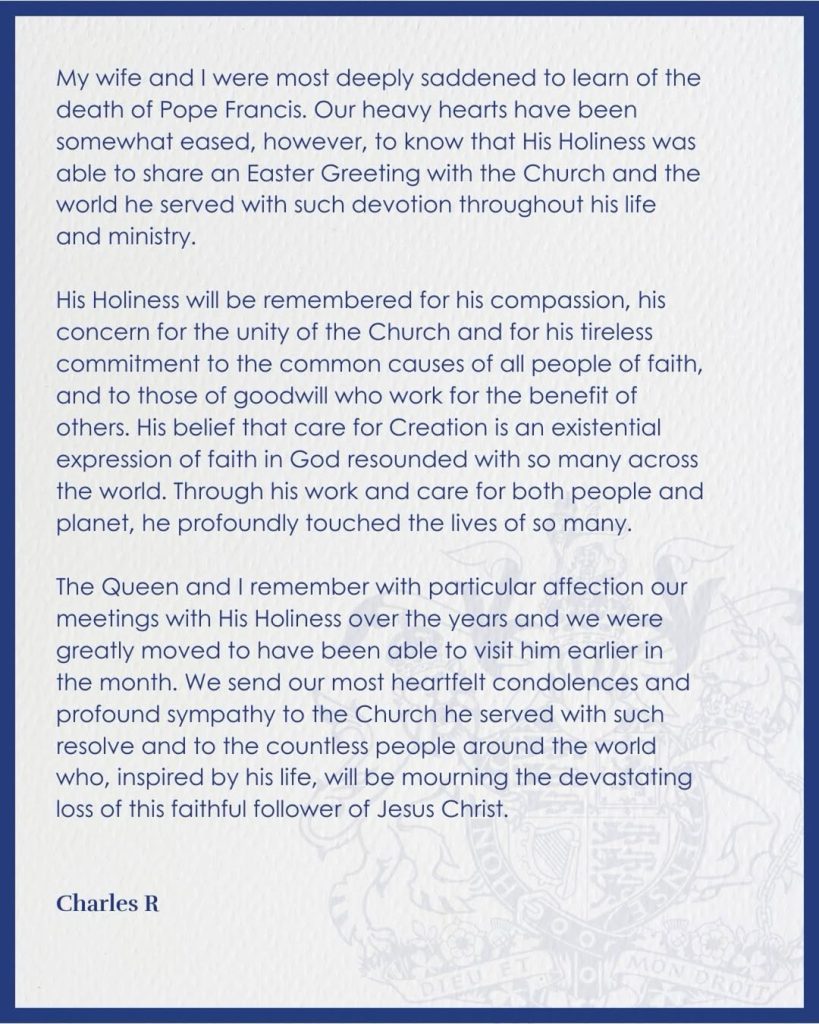
Canadian Prime Minister Mark Carney, who met the Pope during climate talks in 2024, praised his “… deep moral clarity, spiritual courage, and boundless compassion.”
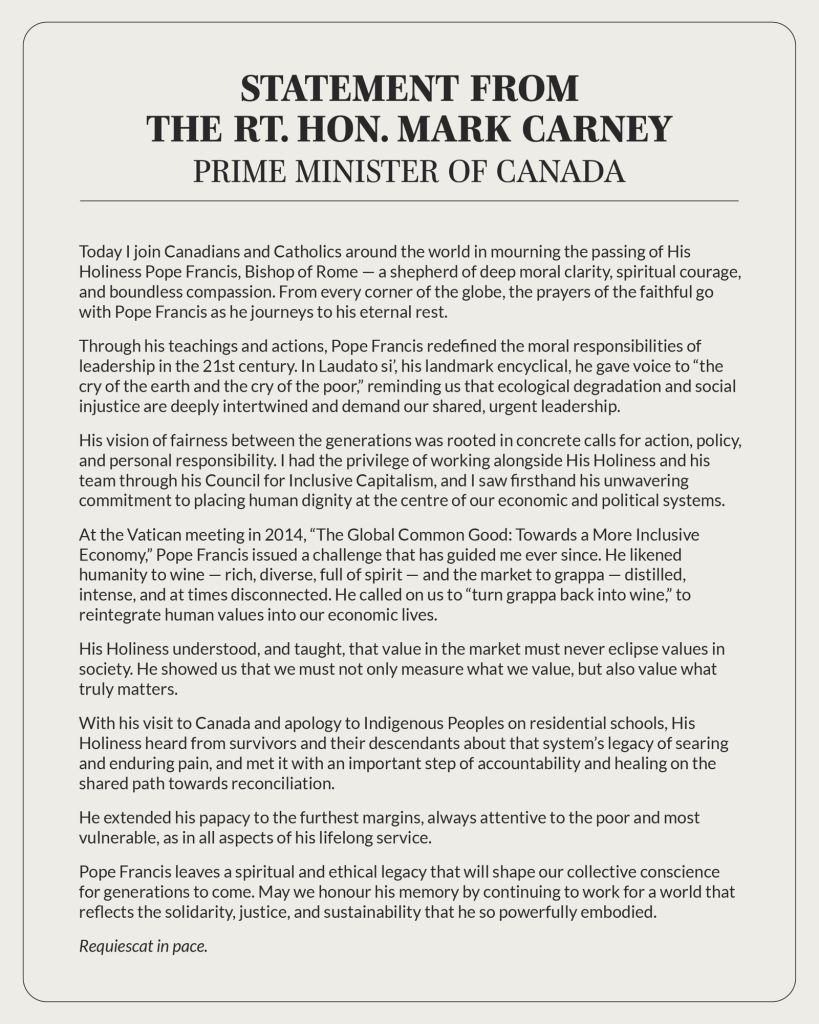
A Papacy of Paradox, a Legacy of Grace
Whether praised as a revolutionary or criticized as divisive, Pope Francis changed the papacy. He was, in the words of one Vatican aide, “a shepherd who smelled like his sheep.”
He never claimed to be perfect — only present. In an age of cynicism, his voice offered something rare: a call to mercy that many had forgotten could still come from Rome.
Editorial Notes:
- April 21 – 11:52 AM PT/2:52 PM ET (New info added) – This article has been updated to reflect the Vatican’s new information on the cause of death and the Pope’s final wishes. President Trump’s full proclamation has also been added.
- April 21 – 8:20 AM PT/11:20 AM ET (New info added) – This article has been updated to include new quotes and statements from King Charles III, President Trump, and Canada’s Prime Minister, Mark Carney.
